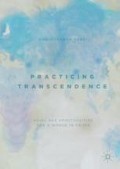Abstract
Global climate change is a highly visible symptom that our world is in crisis and incites anxiety about the plausibility of “the end of the world.” Psychologically, end-of-the-world anxiety is overwhelming, inhibiting our capacity to take responsibility for our world in crisis. Understanding the historical thesis of the Axial Age provides us with a way to gain our bearings on our present moment and put it into perspective. Applying systematic spiritual practices focused inwardly upon consciousness, the signal contribution of the Axial Age helps us to put our present moment into the right scale and develops our mental and spiritual resilience. This chapter summarizes what the Axial Age is, how it is relevant to our contemporary moment, and how it offers hope.
Access this chapter
Tax calculation will be finalised at checkout
Purchases are for personal use only
References
Armstrong, K. (2006). The great transformation: The beginning of our religious traditions. New York and Toronto: Alfred A. Knopf.
Baskin, K., & Bondarenko, D. (2014). The Axial Ages of world history: Lessons for the 21st century. Litchfield Park, AZ: Emergent Publishing.
Bellah, R. (2011). Religion in human evolution: From the Paleolithic to the Axial Age. Harvard, MA: Belknap.
Bellah, R., & Joas, H. (2012). Introduction. In R. Bellah & H. Joas (Eds.), The Axial Age and its consequences (pp. 1–6). Belknap: Cambridge and London.
Fraade, S. (1986). Ascetical aspects of ancient Judaism. In A. Green (Ed.), Jewish spirituality: From the Bible through the Middle Ages (pp. 253–288). New York: Crossroad.
Gardner, G. (2002). Invoking the spirit: Religion and spirituality in the quest for a sustainable world. Washington, DC: Worldwatch Institute.
Halton, E. (2014). From the Axial Age to the moral revolution. Basingstoke: Palgrave Macmillan.
Hamilton, C. (2010). Requiem for a species: Why we resist the truth about climate change. London and Washington, DC: Earthscan.
Jaspers, K. (1953). The origin and goal of history. New Haven and London: Yale University Press (originally published in 1949).
Joas, H. (2012). The Axial Age debate as religious discourse. In R. Bellah & H. Joas (Eds.), The Axial Age and its consequences (pp. 9–29). Cambridge and London: Belknap.
Kakar, S. (2000). The ascetic of desire: A novel of the Kama Sutra. New York: Harry Abrams.
Masuzawa, T. (2005). The invention of world religions. Chicago: University of Chicago.
Momigliano, A. (1975). Alien wisdom: The limits of hellenization. Cambridge: Cambridge University Press.
Nicol, D. (2015). Subtle activism: The inner dimension of social and planetary transformation. Albany: State University of New York Press.
Partridge, C. (2005). Introduction to world religions. Minneapolis: Fortress Press.
Runciman, W. (2012). Righteous rebels: When, where, and why? In R. Bellah & H. Joas (Eds.), The Axial Age and its consequences (pp. 317–334). Belknap: Cambridge and London.
Schwartz, B. (Ed.). (1975). Wisdom, revelation, and doubt: Perspectives on the first millennium B.C. Special Issue of Daedalus, 104(2), 1–7.
Solnit, R. (2016). Hope in the dark: Untold histories, wild possibilities. Chicago, IL: Haymarket Books.
Stuart-Glennie, J. (1873). In the Morningland or the law of the origin and transformation of Christianity, Volume 1: The new philosophy of history, and the origin of the doctrines of Christianity. London: Longmans.
Voegelin, E. (1957). Order and History, Vol. II: The world of the polis. Baton Rouge: Louisiana State University Press.
Voegelin, E. (1974). Order and History, Vol. IV: The ecumenic age. Baton Rouge: Louisiana State University Press.
Ware, K. (1998). The way of the ascetics: Negative or affirmative? In V. Wimbush & R. Valantasis (Eds.), Asceticism (pp. 3–15). New York: Oxford University Press.
Wattles, J. (1996). The golden rule. New York: Oxford University Press.
Wimbush, V., & Valantasis, R. (1998). Introduction. In V. Wimbush & R. Valantasis (Eds.), Asceticism (pp. xix–xxxiii). New York: Oxford University Press.
Author information
Authors and Affiliations
Corresponding author
Rights and permissions
Copyright information
© 2019 The Author(s)
About this chapter
Cite this chapter
Peet, C. (2019). The Relevance of the Axial Age for a World in Crisis. In: Practicing Transcendence. Palgrave Macmillan, Cham. https://doi.org/10.1007/978-3-030-14432-6_1
Download citation
DOI: https://doi.org/10.1007/978-3-030-14432-6_1
Published:
Publisher Name: Palgrave Macmillan, Cham
Print ISBN: 978-3-030-14431-9
Online ISBN: 978-3-030-14432-6
eBook Packages: Behavioral Science and PsychologyBehavioral Science and Psychology (R0)

